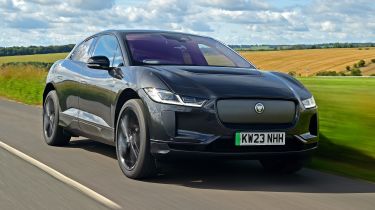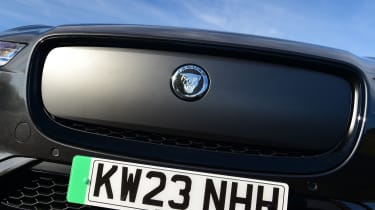New Jaguar I-Pace 2023 facelift review
Jaguar’s latest round of updates can’t hide the I-Pace’s age, but it’s still a strong contender in the EV market

Verdict
It may be getting long in the tooth, but while some EVs have aged badly, the I-Pace still feels remarkably fresh. Few rivals that have arrived since are anywhere near as sharp to drive while remaining this refined, and it’s very spacious inside, too. With improved efficiency and charging speeds to match the newest alternatives, the I-Pace could still be a winner. It’s a little baffling why Jaguar chose to not use such a strong platform for its future electric models.
The Jaguar I-Pace first landed in showrooms back in 2018, which given the spectacular rate of progress in electric vehicles in such a short space of time, makes it positively ancient. If you’re standing still in this market, there’s a strong risk that you’ll fall so far behind that you’ll no longer be relevant.
Fortunately for Jaguar, the I-Pace was an exceptionally strong starting point; it was so good in its day, in fact, that we named it our 2018 Car of the Year.
For 2023, the British brand’s first EV has been treated to some subtle refinements. The most obvious is at the front; the grille moves away from the previous textured panel which mimicked the facias of combustion powered Jags, and is instead replaced with a smooth design finished in ‘Atlas Grey’ paint. A revised Jaguar logo also sits in its centre.
Used - available now

2022 Vauxhall
Mokka
50,623 milesManualPetrol1.2L
Cash £14,790
2023 Ford
Focus
17,010 milesManualPetrol1.0L
Cash £16,995
2023 Kia
Sportage
9,623 milesAutomaticPetrol1.6L
Cash £27,189
2022 Peugeot
5008
27,246 milesManualPetrol1.2L
Cash £19,736The same grey finish is applied to the air vent blades on the outer edge of the front bumper, while the overall look is simplified by replacing the previous gloss black finish for the front bumper, lower door trims, and rear diffuser for body colour.
Speaking of paint finishes, there’s now a pair of satin shades to choose from, and if you go for the panoramic glass roof, the small metal panel between it and the rear window is now black to give the impression of a single, continuous sheet.
Those minor cosmetic tweaks aside, however, little else has changed. It makes it all the more surprising, then, that the I-Pace remains a really strong contender in the EV segment.
It’s clear from the off why we rated it so highly back in 2018, because Jaguar got so many of the fundamentals just right. While it appears some other premium manufacturers are resigned to the fact that a big, heavy EV is never going to be engaging to drive, there’s obvious sophistication here. From the weight and precision of the steering, to the seamless transition from motor regeneration to mechanical braking when slowing down (thought the pedal feels a little spongy initially), everything feels extremely well sorted, even at low speeds.
Find a twisty section of road and it gets even better. During our time with the I-Pace, we also had an Audi RS 7 Performance on test - a spectacularly capable super saloon that delivers a huge amount of excitement. Though the Audi ultimately had more grip and better body control when pushed really hard, the gap between the two was much narrower than you’d expect. In terms of agility, balance and body roll, the Jag proved to be a close match. Turn in is very keen but never hyperactive, and that precision really helps to give the driver plenty of confidence.
Yes, its air suspension settles on a ride quality that is firmer than the Audi Q8 e-tron and the superbly comforting BMW iX, but it could never be considered harsh, and to many the extra sharpness will be a worthwhile trade off. It’s also not as hushed as the eerily silent iX, but it’s still a peaceful place to while away some motorway miles.
The only place where the I-Pace lags behind the best German rivals can be found in its electric architecture. Not so much in the motor itself - 395bhp and a 4.5-second 0-62mph time is still great - but in its charging speeds. At a time when some of the latest EVs - even ones at half the Jaguar’s price - can charge at 150kW or more, the 100kW rate is a little sluggish. Given the huge 90kWh battery pack it has to work with, the real-world range of 248 miles we experienced in perfect EV conditions is a little underwhelming, too.
We’d also liked to have seen one or two more revisions to the interior. It still looks great and feels solidly built, but with other Jaguars benefitting from the latest and brilliant version of the Pivi Pro infotainment system on a huge and responsive touchscreen display, the I-Pace gets the latest software, but on the same, compact screen as before. It does get Apple CarPlay and Android Auto, though, both of which connect wirelessly.
There’s no faulting the space on offer. That cab-forward stance and stretched wheelbase allow for a huge cabin with generous legroom in the back. The 656-litre boot is huge, too.
The model we’re driving here is a newly introduced range-topper. Called the 400 Sport, it features 22-inch alloy wheels, air suspension with adaptive dampers and a subtle rear spoiler as standard. At £79,995, it’s £10,000 more expensive than the entry-level R-Dynamic S trim, but that car misses out on the air springs and gets smaller wheels.
| Model: | Jaguar I-Pace 400 Sport |
| Price: | £79,995 |
| Powertrain: | 90kWh battery/ 2x e-motors |
| Power/torque: | 395bhp/696Nm |
| Transmission: | Single-speed automatic, four-wheel drive |
| 0-62mph: | 4.8 seconds |
| Top speed: | 124mph |
| Range: | 255 miles |
| Charging: | 100kW (78 miles in 15 mins) |
| On sale: | Now |










